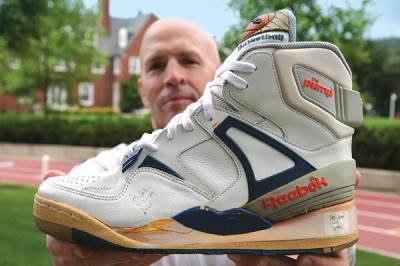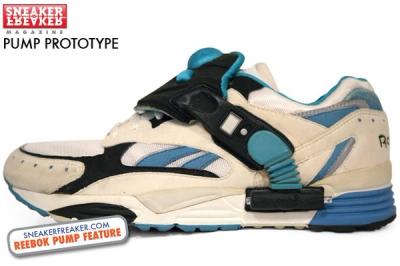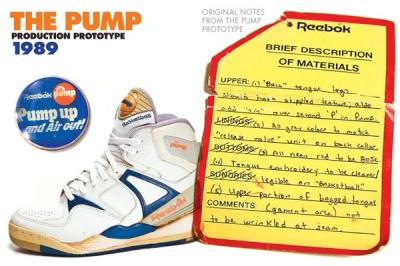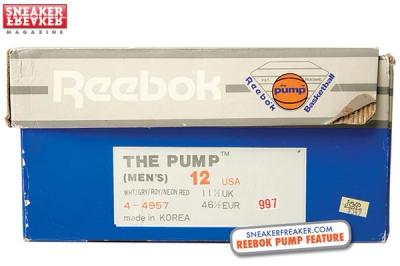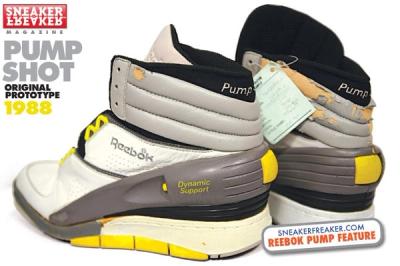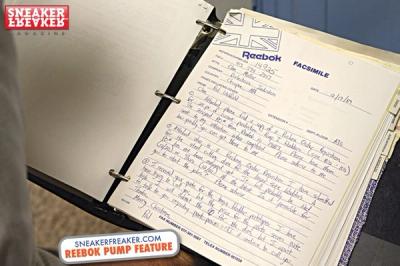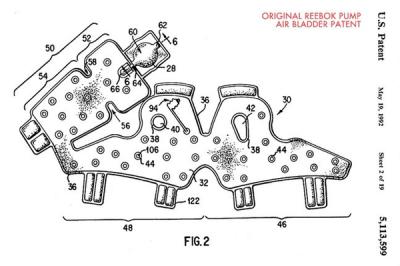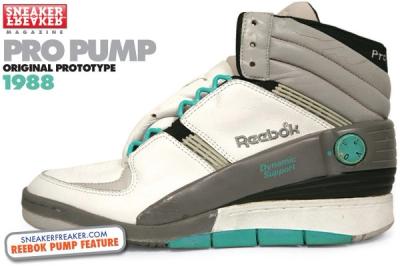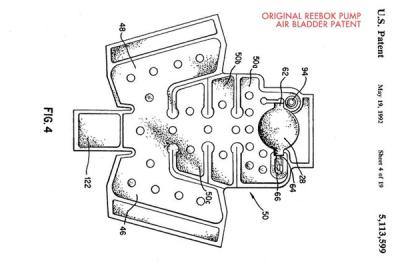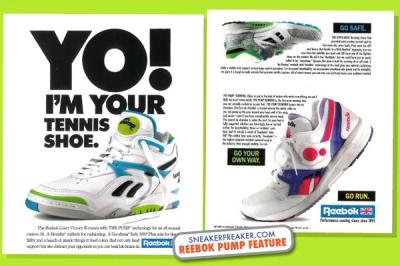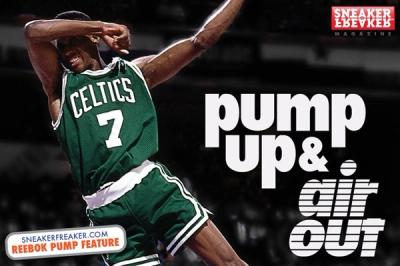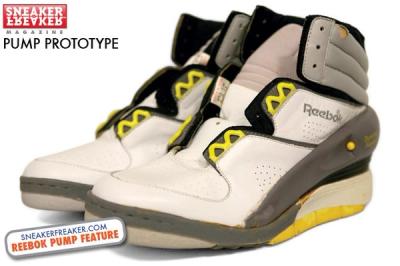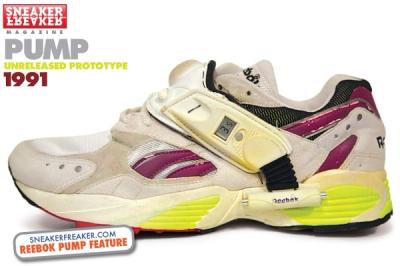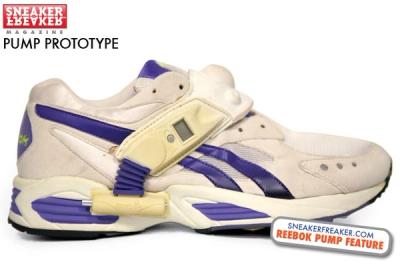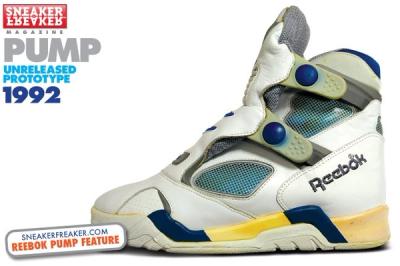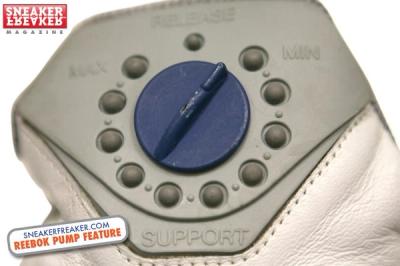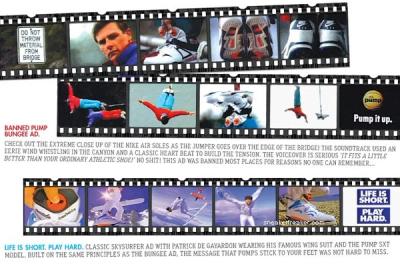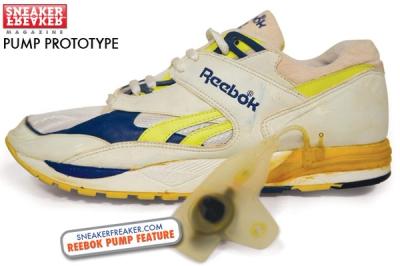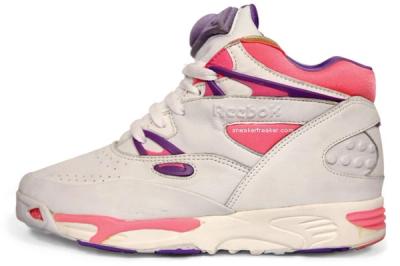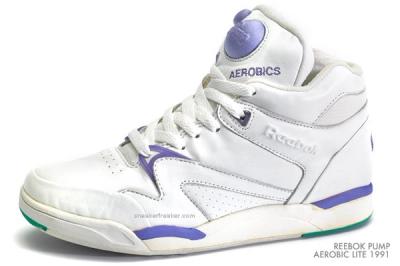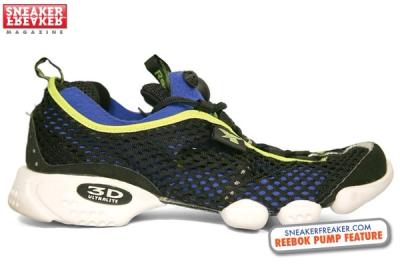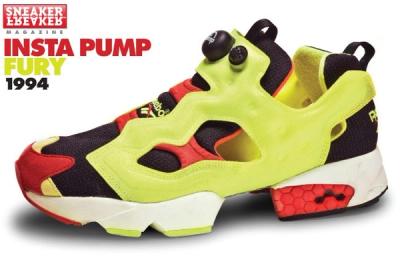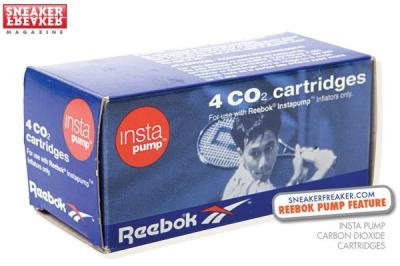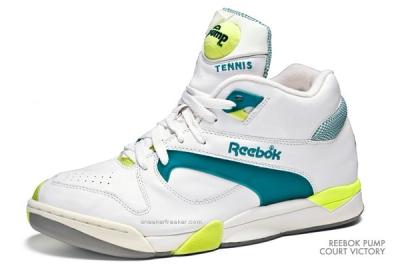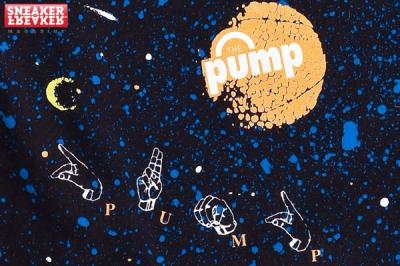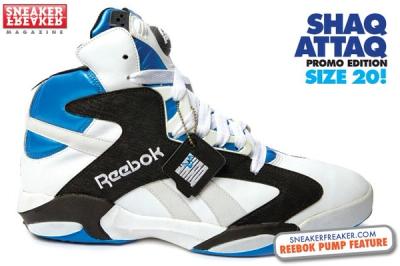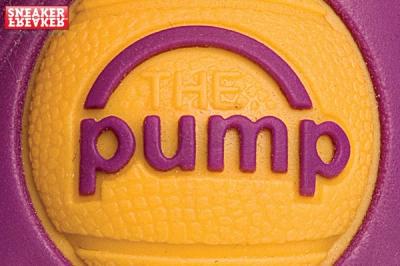Reebok Pump Designer - Paul Litchfield
One of the great privileges of our job is spending quality time with the wily old veterans of the shoe biz. After decades in the trenches, they’re usually obstreperous, charismatic and wildly entertaining story tellers. In the case of Reebok, Paul Litchfield is all that, and a corporate treasure to boot. After joining the firm in 1985, Paul was the project manager for Pump and also oversaw the development of Hexalite and ERS. Challenged by Paul Fireman to ‘make Pump work’ within a few measly months, Paul accepted the gauntlet and helped push Reebok to become the world’s biggest footwear brand by the late ‘80s. Now Vice President of Advanced Concepts, Paul is still a hard charger, designing and refining the next generation of Reebok innovation. Take some time to absorb the inner workings of The Pump’s progenitor...
Hey Paul. Tell me about your background before you got into the shoe business?
Before I got into the shoebiz I received my undergrad degree in biochemistry and my masters in exercise science and muscle biochemistry. I did some research up in Aberdeen Scotland on human performance through funding from oil companies out in the North Sea. I also did a bunch of research for Nike, believe it or not. I then came back to work on my PhD and as a result of academic politics, I ended up walking away. I had an interview with this really small company in the Boston area called Reebok where there were six people in the R&D department. We had a great time playing hoops and it was the most casual, fun interview I’d ever had. I was like, ‘alright I’ll try this!’
Where you into the shoes or was it the office vibe?
I was a bit of an athlete, but I wasn't a shoe maven or anything like that. I was familiar with Nike ‘cause I had done some undergrad classes and I knew about the human performance side but I wasn't a shoe dog, I just thought that maybe I could parlay my education into a way to help make better shoes.
Do you mean as a designer?
More the engineering side of things. In the shoe business you have designers, which are the stylists then you have what they call developers, who do the building. I'm more of an engineer, although not by education. What I found was that I actually understood chemistry pretty well. So I worked with Goodyear Rubber and DuPont and the resin companies to make use of plastics, which are a big part of the business, from outsoles to reinforced supports and straps on uppers. I never was a designer but understood and respected the process.
So about the time you join, this small company starts making the Freestyle aerobics gear?
The Freestyle actually started in about 1982. It was a high-tech ballet shoe that women could do aerobic dances in. When I joined in ‘85, it was starting to take off. In ‘86 and ‘87 it was like a rocket, it just took off!
Freestyle is one of the success stories of the decade. For such a small team, you created a juggernaut pretty quickly.
Yeah, it was, it was wicked intense! Reebok was always pretty lean and Paul Fireman was famous for saying, ‘You have a shoe design and you've got a factory. What do you need anything in the middle for?' That was us, we built the stuff! (laughs) Towards the end of the ‘80s we launched the Energy Return System (ERS) and the Reebok Advanced Group consisted of exactly three members.
Do you mean they advanced from two to three when you joined?
Exactly! It was pretty funny. We networked well.
The first Mac computers are right about then as well.
Oh, yeah. Absolutely. But we worked on everything by hand. It was funny because when I first started it was Telex and then it was faxes. So what you'd do is, you'd handwrite your sample requests with all of your notes and then you'd take them to the fax machine. We actually had departments where people would spend two, three, four hours a night feeding paper into the machine! We had it scanned and sent over to our counterparts in Asia. Then you'd take these big wads of paper and you'd carry them on a plane and make shoes.
Faxes don't last forever...
Hell, no! Let me show you something. Yeah. Check this out! They're all yellow! It's like invisible ink! These are all my faxes. Every single meeting I ever had at Reebok I made notes and I kept it all. Look at this! Isn't it incredible?
- Interview adjourns for 15 minutes while we check out the folders.
What were the ‘80s like for you personally? Did you have the big hair? What were you into?
A lot of bad hair... now I'm bald as a stick! But it was funny, being at Reebok was really cool because we were popular and we couldn't make the shoes fast enough. Whatever we made seemed to be a hit. When we went from aerobics into the basketball marketplace in North America, it was a success. People were clambering to be part of the company, whether they were employees or retailers or athletes. It was really cool.
Did you have a sense of reality about this time? You had to survive each week no doubt, but it must've been a blast.
You had to survive every hour in this place! It wasn't like a threat to life or limb, but it was a relentless pace and it was crazy. And Paul Fireman, if nothing else, was never satisfied. It was always like ‘Ok great, now next! Ok great, now next!' It created an environment of significant intensity. It was cool to be part of it but it was also pretty draining.
If you look at the overall period of shoe design across all companies, the acceleration of ideas and technology was frenetic. adidas had Torsion, Reebok had Pump and ERS and Nike had Air amongst others. What is it about that decade that created such intense rivalry in design?
Yeah I think so as well! Athletic gear was clearly the moniker of the day, it was like cell phones are now so there was an appetite for that from the consumer. It was a flat-out race to see how technical your shoes were and how much value you could put in them. When I did the Pump in 1988 and ‘89 as the project manager, we also had Hexalite and Graphlite. We had the second generation of ERS as well, so we created four new technologies out of a really small group.
You make it sound like Pump was just another one of your ideas...
It was funny because it wasn't until Paul Fireman held it up at one of the trade shows, I think it was ISPO in Munich, and said ‘This is the Freestyle of the ‘90s!' that the idea took off. Like you said, the Freestyle was the definition of success, and Paul created this critical mass of enthusiasm for the models.
Did the idea originate with you?
No it didn't. When Paul Fireman bought Ellesse, they had a ski boot with this pumping mechanism and it had big brass fittings and stuff like that. Somebody said to Fireman, ‘Hey, you should put this contraption on a shoe!' but for a while there, it languished and no one took it seriously. It looked like an iron lung...
Sounds medieval...
Yeah, yeah, yeah! It was just a rough prototype idea. If you look back in the US patent literature, there's all kinds of inflatables and pumps.
The 1890s I think is the first reference in the patent. That did strike me as odd.
Yeah, 1892. Exactly! That keeps you pretty humble because it's like, ‘Did you invent the Pump? Oh yeah! Apparently not!' I was given the task, the unenviable task to make a shoe out of it. We were looking to make a customisable-fit shoe and we looked at foams and straps and ended up settling on a Pump mechanism which was hollow so you could change the shape by inflating it. We didn't have spare designers and development people, so a local Boston design firm and I basically worked on making the first Pump shoe, probably in early 1988.
Was it always called Pump?
No, not at all. We had a bunch of different names and a lot of them were around ‘air or ‘custom'. It wasn't called The Pump until much later in the process and when we finally got down to launch this thing, turns out a shaving cream company had a thing called The Pump! So from a legal perspective, that's why it's always ‘The Pump by Reebok'. I mean it was pretty seat-of-the-pants until you ran into a problem and then you had to get through somehow.
There's two really distinctive things about the shoes. One was the name and the other was the basketball logo which doubled as the mechanism. The manual pumping system was crucial to its success.
Exactly. When we first did the shoes, we just looked at how to make bladders. There weren't many people that made the kind of dynamic air bladders that we wanted. You could do an air mattress that might float around the pool, but that always leaked eventually. We ended working with a medical grade company that made blood bags and intravenous bags and things like that.
Tell me about the first prototypes here... They look pretty far out!
The Pump Shot and the Pro Pump were the first shoes that we showed at the Atlanta Super Show in February of 1989. Myself and Duncan Scott and the guys at Design Continuum worked on these. This is the pump on the back of the heel and this little valve is the same as a bicycle tyre. They were a colossal pain in the ass. The pump bladder itself goes up the tongue and around the whole shoe and then around your ankle. When you pumped it, you could feel it!
Now this Pro Pump had a little valve that basically closed and then opened up like a dimmer switch. This one actually had a heel pump. So you stepped on it and like a little bellows, it pumped up the bladder. We did a bunch of testing at local high schools and believe it or not, kids didn't like the auto-pump because it was slow and subtle. What they liked was pumping up their shoes before they got on the court.
Wasn't the Nike Air Pressure also at the Super Show?
Ha! Yes it was. At the same time while we were showing this stuff, Nike was showing their shoe called the Air Pressure. They showed it under glass where you couldn't touch it and with the bright lights it looked like a rock star!
So how did you feel seeing their shoe?
I was horrified! At the time, we had this secret room where you could come in and try our shoes on and people were really excited. We were getting high fives already! But I was horrified because they weren't totally finished. I actually had just given the designs to our senior designer Paul Brown who had also done Freestyle. In less than a week, he came back with a shoe drawing that looked exactly like The Pump. And as soon as I saw it, I'm like ‘That's it!' Paul was the one who said ‘We'll make it look like a basketball!' That was the huge breakthrough we needed. I'm not a designer but you know when something's right. Our shoe was elegant, it was simple and it was stylish.
Agreed. It's tactile as well. Using the basketball as the pump was genius.
Absolutely! As soon as we made this shoe (picks up the first The Pump sample), we used a rubber material that basically felt like a basketball. You pumped it up and then when you released the air, it came out and made a hissing sound.
So it had... Audio as well! They look gigantic by today's standards.
Well at the time, high tops were high tops and they hadn't invented the mid cut yet. Nowadays I don't think they make a true high top ball shoe anymore, they're all mid cuts to me. That was just the working height of the day. It's simply the evolution of style.
What was the reaction?
Ok, so this is February of ‘89. The selling cycles were big back then, so Fireman said ‘We're going to have this shoe by Holiday!' and I'm like ‘Are you out of your mind?' Paul was pretty clear that if I was picking up a pay cheque in December, it was because this thing was done. It was big-time pressure! But Fireman was the kind of guy who could throw out these impossible deadlines and yet somehow, you thought you could do it. We went at it really, really hard and by September of 1989, we had about 7,000 pairs on order. Foot Locker did it as a favour to our VP of sales I think. It was $170 on the shelf. It was an inflatable shoe, they must've thought we were nuts.
Why did they cost $170? This is 20 years ago so...
Yeah no kidding. Basketball shoes at the time were costing about $100, and when you included the Pump, it went up to $170 because it was a whole new technology threshold. I think that's why there was such trepidation. We had the right balance of value and interactiveness and you had to aspire to go get it! You had to beg your mum and dad or work quite hard to get that extra money. When you bought a pair of Pumps, you were pretty much the cat's ass at the time.
Or stole them. (Laughs)
Yeah exactly. That happened too! Remember I used to make them and that made me totally cool.
Why do you think The Pump survived and the Nike version didn't?
As you said, these are big shoes and the Nike had this even bigger goitre on the back of your foot. No disrespect, but it looks peculiar. They also had a butterfly pump which pushed against your Achilles. With ours you didn't have to bring anything with you to pump the shoes and at the time, Reebok was considered cool.
Did the production run smoothly?
No! Check this out! This is just a little anecdote. The bladders were made here in Massachusetts and they were tested for three hours, then again for 24 hours before being sent to Korea. The factory inflated the Pump bladder and tested it again, then they stitched it into the shoe and inflated it again to make sure that no one had sewn through them.
So the bladder's been inflated five, six times to make sure that these things don't leak. When we get the first shipment a few weeks later, I get a call from our warehouse saying that none of these things inflate! I get down there and it's like someone has poked a hole through every single one of them. As it turns out, the shoe factory decided to use a sewing machine (without the needle) to test the Pump mechanism. It seemed to make sense, but the sewing machine damaged the Pump mechanism so that after this final inflation
test, the Pump would not inflate the bladder again.
Disaster... how did you fix the problem?
We had to take every single pair of Pumps, take the stitches off, pull the Pump out and put a new one back in and sew it back up. 7000 pairs! Like we haven't done enough for this Pump thing already?
You did them all by hand?
Probably about six of us, yeah. It wasn't a small number of shoes believe me. Then we had to make sure that they worked, so it was pretty intense.
Is it cool to have a patent to your name?
Well it's nice, but it's just part of the process. Once you submit the application, there's a lot of legal channels it has to go through before the final patent comes out. It's just a footnote really, it's not like a celebration of anything. It protected our domain and represented the accumulated knowledge that we all gained. It's how you put it all together that makes it unique and that's the most important thing - the blend of all these ingredients in our Pump system.
MANY people consider Pump a gimmick. What do you say?
Oh yeah sure, absolutely. I'm sure it's a punchline in some ways but I would say we took a mass manufactured shoe made on a last which is an average shape and we made it custom fit anyone's foot. All feet, left and right, are slightly different and our intention was to fill all the voids between your foot and the shoe, so it becomes properly fitted. That's what this Pump bladder does! It works and people can call it a gimmick if they want, but it works.
I don't think they say it as a negative, it's more just the convivial nature of it.
There's definitely a fun aspect and an interactive aspect as well. But comfort is all part of performance and I think Pump is all those things.
What did your athletes think of them?
When we gave them to our athletes, we gave them instructions on how many times they should pump it up, but we found out pretty quick that some people pumped it ten times and some people pumped it 80 times. And then they'd pump it just to hear the air release! It became this cool little fad and it really caught on.
I know you weren't involved in the marketing, but I did want to ask you about the impact Shawn Kemp, Dominique Wilkins and most importantly Dee Brown and Michael Chang had.
They were huge! Don't forget Boomer Esiason, Doc Rivers and the late Dennis Johnson. These guys were huge ambassadors for the Pump! I think Dominique pumped his up fifty, sixty, eighty times and he just really liked them. If it wasn't for our athletes enthusiastically endorsing Pump, if it wasn't for our advertising and marketing folks putting together important messages at the same time, who knows? Everything converged at the right time and it made it seem like it was bigger than life, and then all of a sudden it really took off!
The Pump advertising is still powerful now. The trash talking is funny and showing a competitor's shoes in ads is something you don't see these days.
Oh yeah, it was funny as hell. We did this whole bungee thing and then ended up pulling it because some kids were trying something like it at home. It's so in-your-face! He bends down, they're bungeed up, look at this, it's so cool. He pumped up his shoes! This was when bungee jumping was a really big deal. Let me show you...
Paul plays the ad on his laptop.
The ad is so quiet. It's not overblown with LOUD sound effects or anything.
Yeah, yeah! And then you're thinking, what the hell's going on? I wasn't involved with the filming of that but I thought that was so hip!
Do you remember the Dee Brown dunk?
Absolutely. I watched it on TV. When he did that, it was wicked cool! Shawn Kemp and Dominique Wilkins were there as well from memory. You gotta remember that Dee's a relatively little guy - he's like six foot one or something - and these other guys were big dunk monsters! When Dee gets it centre court and all of a sudden puts the ball down, bends over and starts pumping up his shoes, everyone went nuts! Then the best part about it was his ‘No look dunk!' I've still got a big poster of it up in our lab.
What about Greg Norman? He was never a trash talker but he dissed Curtis Strange.
Exactly. Greg was always very open, always had a smile and something nice to say. It was always in good humour. He was a great spokesman for Reebok.
Were you still involved in Pump when Shaq came aboard?
Oh yeah, I met Shaq when he was being signed. He came up here with his mum and dad and we met him. Shaquille O'Neal's a big guy, he's a big man. I'll show you some of the shoes we made for him. They're colossal! He was a super-serious athlete but also good for a laugh. He was bigger than life.
What was it about the ‘80s that created this competitive culture? You guys got a little bit cocky as well - you really hammered Nike. A little bit?
Not a little bit, I think a lot! (Laughs) I wasn't involved with the advertising, but there was a lot of showmanship in the industry at the time and it was a lot of in-your-face friendly fire. It's like Coke and Pepsi or Microsoft and Mac with their 1984 ad. Everybody went at each other pretty hard.
Did it ever get personal? I've heard stories about staff being poached and all sorts of things... you guys whipped their ass for a few years.
Absolutely. Reebok was the biggest athletic footwear company in the world! You never took the time to stop and rest on your laurels because Fireman wouldn't allow it, but it was pretty cool. We wore our Reeboks pretty proudly. Actually most of the athletic shoes at the time were made in Pusan, Korea. It's only four to five million people and in the ‘80s, it was the athletic footwear capital of the world! You had a whole bunch of expats, mainly Americans and Germans and only two or three hotels that could accommodate westerners comfortably. There were never any dust ups, no fisticuffs - well none I can really mention - but it was healthy rivalry!
The Insta Pump is still a striking piece of modernism. Were you involved in the development?
Oh yeah, absolutely! Check this out. Paul Fireman wanted one of our athletes to go to the Olympics and run the 100 metre dash and get to the starting line, inflate their shoes and take off! And so we're like, ‘How the hell are we going to do that?'
Me and Steven Smith, who was my advanced concepts designer, were at this annual bicycle show called the Inter Bike in Anaheim, California. There was a thing called Insta-flate which you used if you got a flat tyre during a bike race. You'd replace the inner tube and then insert this CO2 cartridge and it would dump all the gas and you could take off. We saw these guys Geoff Bleaker and Tony Hollis from Innovations In Cycling and they're like ‘Go for it! Do what you want!' You'd basically stick the nozzle in and watch this thing instantly inflate. Fireman was really, really happy with that and everybody was super psyched. That Pump Fury to me was a benchmark shoe, up there with the first Pump with the orange ball. Rather than taking a Pump bladder and then sandwiching it inside an existing shoe, we took everything off except for the bladder itself. A lot of this material is there just so that you wouldn't see people's socks or their feet!
Pump kept evolving and still is, but at some point, it seemed to lose people's imagination. Would you agree?
Absolutely, without a doubt. As a matter of fact, when we launched the Fury, it wasn't that successful at first because it was so peculiar. It was a good running shoe, but it was peculiar. It had no laces, it was a wild colour, it had no arch and people were asking ‘What the hell is that thing!'
In hindsight would you have put an arch in it?
No I wouldn't change it at all. You put the Pump Fury on the shelf, particularly at the time, and fifty people would look at it and go ‘That's the coolest thing ever!' Fifty people would look at it and go ‘That is the ugliest thing I've ever seen!' but 100 people would notice it, and that's important.
It's also one colour combination that Reebok definitely owns.
Without a doubt. I'm not a designer but I listened to Steven's opinion on that and thank God we did.
Getting Jackie Chan onboard didn't hurt either.
Absolutely, he's way cool! That shoe's got its own cult following. I'm pretty proud to have worked on that one.
Given what you achieved with Pump, do you ever feel that you've done everything you possibly can with a sports shoe?
Once I start patting myself on the back, I'm going to hang up my boots, because clearly you think you know it all. We're proud of what we're able to produce and if people buy into it, that's very cool. Hopefully that will keep me amused enough to keep striving and make things more interesting.
Well I guess that's the nature of evolution. We should all be making things better.
Yeah it is.
THANKS PAUL...
Make sure you check out our complete Pump20 coverage!
